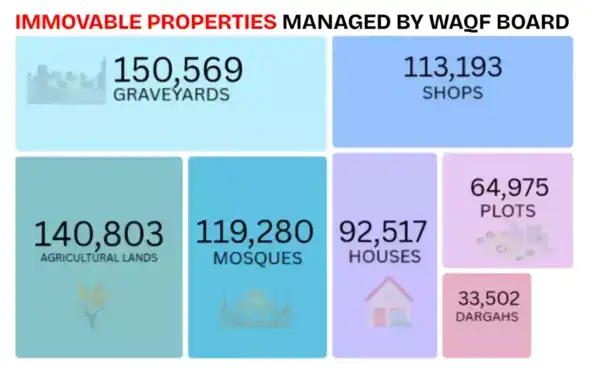Table of Contents
NEW DELHI: The Supreme Court on Wednesday questioned the Centre’s move to remove the concept of “waqf by user” from the Waqf Amendment Act, 2025, warning that such a change in the legislation could potentially erase the status of thousands of longstanding religious properties across India. However, the Centre opposed the court’s directive and sought a hearing.
The top court’s bench said, “The properties declared by courts as waqfs should not be de-notified as waqfs, whether they are by waqf-by-user or waqf by deed, while the court is hearing the challenge to the Waqf Amendment Act 2025.”
Supreme Court’s observation
The CJI-led bench asked the Centre how waqf properties established through uninterrupted religious or charitable use — but lacking formal documents – would now be treated. “How will you register such waqfs by user? What documents will they have? It will lead to undoing something. Yes, there is some misuse. But there are genuine ones also,” the court observed, citing legal precedents that have so far recognised such waqfs.
Follow live updates
The court also questioned the exclusivity of waqf board membership, mentioning, “All members of the waqf boards and Central Waqf Council must be Muslims, except ex-officio members,” and asked whether Hindus would be allowed to participate in their own religious trusts, highlighting questions of parity in religious administration.
What is waqf?
A waqf is a permanent dedication of movable or immovable property by a Muslim for religious, pious, or charitable purposes recognised by Islamic law. It is typically managed by a ‘mutawalli’ (caretaker), and cannot be sold or transferred.
What is ‘waqf by user’?
‘Waqf by user’ refers to the practice where a property, such as a mosque, dargah, graveyard, or community kitchen, is treated as waqf not because of a formal written deed, but because it has been consistently and openly used for religious or charitable purposes over a long period.
This concept was legally recognised through court rulings and codified in the Waqf Amendment Act, 2013, passed by the UPA government.
It allowed properties to be recorded as waqf even in the absence of documentary proof, based on community usage and long-standing public acceptance.
The idea was to protect heritage structures that predated modern land registration systems.
Also read: In 10 big numbers – Waqf and its properties in India
4.02 lakh ‘waqf by user’ properties across India
According to data available on the Waqf Assets Management System of India (WAMSI) portal, 30 states and Union territories along with 32 Boards have reported a total of 8.72 lakh Waqf properties, spanning over 38 lakh acres. Of these, 4.02 lakh properties are classified as “waqf by user.”
Waqf properties in India form one of the largest networks of religious and community-owned land globally, encompassing a diverse range of assets across the country.

These include 1,50,516 graveyards (17%) and 1,19,200 mosques (14%). Commercial properties such as shops (1,13,187) and houses (92,505) contribute to the economic sustenance of the Waqf system. Additionally, 1,40,784 properties are agricultural land (16%), while religious sites like dargahs and mazars account for 33,492 properties.
2025 amendment: A bone of contention
The Waqf Amendment Act, 2025, introduced by the NDA government, removed or majorly limited the concept of ‘waqf by user’. It made documentary ownership a requirement, stating that only a “practising Muslim for at least five years” who is the legal owner of a property can declare it as waqf.
The Centre argued that the 2013 law led to “misuse and wrongful classification” of lands — including government or private property — as waqf, often without valid proof.
Critics, however, fear that the amendment could jeopardise “centuries-old Islamic institutions” that lack formal records but have served as religious spaces for generations.
The 2025 law does offer some protection by stating that already “registered” waqf-by-user properties will remain so — unless challenged or identified as government property. But concerns remain over thousands of sites that may be “unregistered or under dispute”.
Waqf laws in India so far
India has a long legislative history concerning waqf, dating back to British rule:
- 1913 & 1923: Early laws validated and regulated
Muslim endowments . - 1954 & 1995: The Wakf Acts created State Waqf Boards and the Central Waqf Council.
- 2013: Major reforms by the UPA included formal recognition of waqf by user, stricter rules against property misuse, inclusion of women on waqf boards, and expanded lease rights.
- 2025: The NDA’s amendments aimed at tightening definitions, curbing misuse, and boosting transparency—sparking debate about historical erasure and administrative overreach.
Supreme Court’s hearing to be resumed
The Supreme Court has not yet issued a formal order but will resume hearing the matter on April 17. A battery of senior lawyers, including Kapil Sibal, Abhishek Manu Singhvi, and Solicitor General Tushar Mehta, are representing various petitioners and the Union government.


